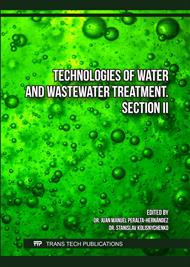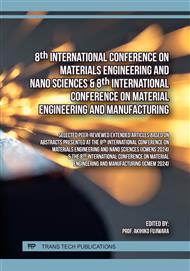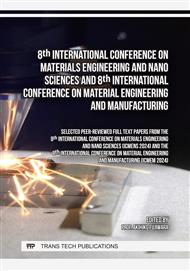[1]
V. Vliet, M. TH, E.R. Jones, M.T. Flörke, W.H.P. Franssen, N. Hanasaki, Y. Wada and J.R. Yearsley: Environmental Research Letters 16. no. 2 (2021).
Google Scholar
[2]
M. Kamali, L. Appels, E. E. Kwon, T. M. Aminabhavi, and R. Dewil: Chemical Engineering Journal. vol. 420 (2021) 129946.
DOI: 10.1016/j.cej.2021.129946
Google Scholar
[3]
K. D. Sharma and S. Jain: Social Responsibility Journal. vol. 16. no. 6 (2020) 917–948.
Google Scholar
[4]
P. Krasucka, B. Pan, Y. Sik Ok, D. Mohan, B. Sarkar, and P. Oleszczuk: Chemical Engineering Journal. vol. 405 (2021) 126926.
DOI: 10.1016/j.cej.2020.126926
Google Scholar
[5]
F. Amalina, A. S. A. Razak, S. Krishnan, A. W. Zularisam, and M. Nasrullah: Cleaner Waste Systems. vol. 3 (2022) 100051.
DOI: 10.1016/j.clwas.2022.100051
Google Scholar
[6]
K. Safo, H. Noby, M. Matatoshi, H. Naragino, and A. H. El-Shazly: Research on Chemical Intermediates. vol. 48 (2022) 4183–4208.
DOI: 10.1007/s11164-022-04807-5
Google Scholar
[7]
K. Nihan and Z.Y. Uzun: Biomass Conversion and Biorefinery. 11 (2021).
Google Scholar
[8]
A.M. Omar, A. Hassen, O.I. Metwalli, M.R. Saber, S.R. Mohamed, A.S. Khalil: (2021). Nanotechnology. 32(33), p.335605.
Google Scholar
[9]
Y. Dai, N. Zhang, C. Xing, Q. Cui, and Q. Sun: Chemosphere. vol. 223 (2019) 12–27.
Google Scholar
[10]
M. Bilal, I. Ihsanullah, M. U. Hassan Shah, A. V. Bhaskar Reddy, and T. M. Aminabhavi: Journal of Environmental Management. vol. 321 (2022) 115981.
DOI: 10.1016/j.jenvman.2022.115981
Google Scholar
[11]
H. He, R. Zhang, P. Zhang, N. Chen, B. Qian, L. Zhang, J. Yu, B. Dai: Advanced Science. (2023) 2205557.
Google Scholar
[12]
N. M. Musyoka, B. K. Mutuma, and N. Manyala: RSC Adv. vol. 10. no. 45 (2020) 26928–26936.
DOI: 10.1039/d0ra04556j
Google Scholar
[13]
B. Krishnappa, S. Saravu, J. M. Shivanna, M. Naik, and G. Hegde: Environmental Science and Pollution Research. vol. 29 (2022) 79067–79081.
DOI: 10.1007/s11356-022-21251-5
Google Scholar
[14]
B. R. Patra, A. Mukherjee, S. Nanda, and A. K. Dalai: Environmental Chemistry Letters. vol. 19 (2021) 2237–2259.
Google Scholar
[15]
S. Liu, Y. Wang, Z. Feng, Y. Wang, and T. Sun: New Journal of Chemistry. vol. 45 (2021) 17418–17427.
Google Scholar
[16]
K. Gupta, D. Gupta, and O. P. Khatri: Appl Surf Sci. vol. 476 (2019) 647–657.
Google Scholar
[17]
Y. Hou, Y. Liang, H. Hu, Y. Tao, J. Zhou, and J. Cai: Bioresour Technol. vol. 329 (2021) 124877.
Google Scholar
[18]
L. Sunthar, T. Asharp, and K. Nadarajah: Water Air Soil Pollut. vol. 234 (2023).
Google Scholar
[19]
A. Ouedrhiri, M.A Himi, B. Youbi, Y. Lghazi, J. Bahar, C. El Haimer, A. Aynaou, I. Bimaghra: Materials Today: Proceedings. (2022) 66:259-67.
DOI: 10.1016/j.matpr.2022.04.928
Google Scholar
[20]
B. Zhang, Y. Wu, L. Cha: Journal of Dispersion Science and Technology. (2019).
Google Scholar
[21]
O. Kayanja, A.A. Abdel-Aty, M.A. Hassan, A. Hassanin, H. Ohashi, A.S. Khalil: 2023. A Review on TMDCs Nanomaterials and Their Surface Engineered Polymeric Membrane Nanocomposites for Water Remediation and Wastewater Treatment. Surfaces and Interfaces, p.103578.
DOI: 10.1016/j.surfin.2023.103578
Google Scholar
[22]
A. Gopalakrishnan, S. Badhulika: (2021). Journal of Energy Storage. 38. P.102533.
Google Scholar
[23]
H. Zhang, R. Li, Z. Zhang: (2022). Environmental Pollution. 293. P.118517.
Google Scholar
[24]
A.M. Omar, O.I. Metwalli, M.R. Saber, G. Khabiri, M.E. Ali, A. Hassen, M.M. Khalil, A.A. Maarouf, A.S. Khalil: (2019). RSC advances. 9(49) pp.28345-28356.
DOI: 10.1039/c9ra05427h
Google Scholar
[25]
A.F. Meese, D.J Kim, X. Wu, L, Le, C. Napier, M.T, Hernandez, N. Laroco, K.G. Linden, J Cox, P. Kurup, J. McCall:. ACS ES&T Engineering. 2021. ;2(3):465-88.
DOI: 10.1021/acsestengg.1c00282
Google Scholar
[26]
U.N. Murthy, H.B. Rekha, J.G. Bhavya: journal of environmental science and development. 2011 1;2(6):483
Google Scholar
[27]
A.Rahman, N. Kishimoto, T. Urabe: International Journal of Environmental Science and Development. 2013 1;4(5):558.
Google Scholar
[28]
A.K. Verma, P. Bhunia, R.R. Dash: International Journal of Environmental Science and Development. 2012 1;3(2):118.
Google Scholar




